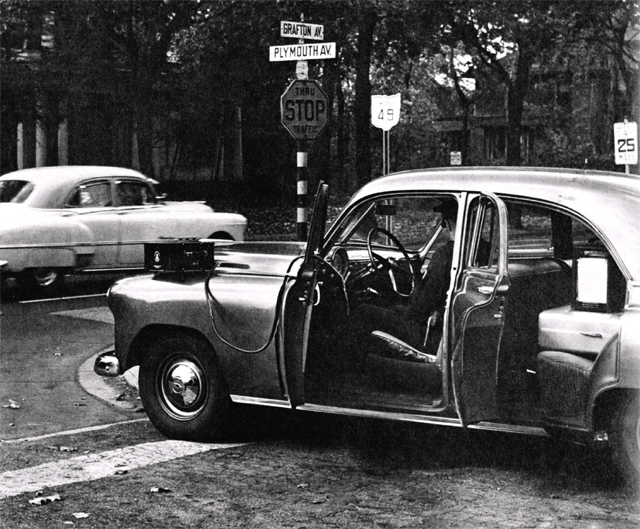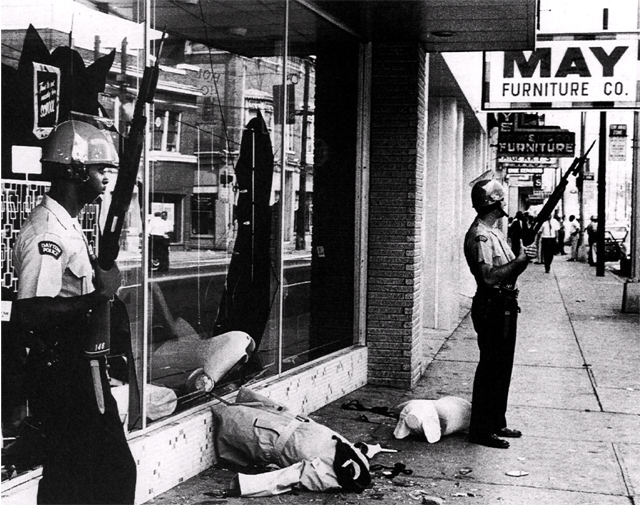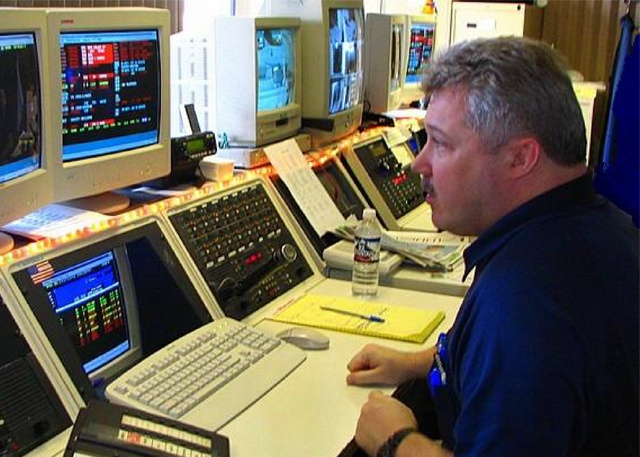New Age of Professional Standards
1950 – 1965

Dayton Police Traffic Enforcement with Radar Unit circa 1950
In this new age of policing – after the stagnation in both manpower and resources caused by the Great Depression and the nation’s war needs – changes to bring the police force up-to-date in its professional standards were being made. Those changes could be found in training, procedures, facilities and equipment.
By 1950, Dayton’s population was 243,872 and the police force numbered 266. In 1953, the weekly work schedule was reduced to a 40-hour, five-day work week and patrolmen were being paid $349.00 per month.
During the Korean War (1950 – 1953), the Auxiliary Police were created with the enactment of the national Civil Defense Act of 1950. As had WWII, the Korean War lessened the manpower available to the police division. The primary purpose of the Auxiliary Officers was to direct traffic to air raid shelters and to control people at these shelters. In reality, they assisted with uniformed patrol, traffic direction and crowd control at accidents, fires, demonstrations and other major events. They had no powers of arrest and were disbanded as soon as the war ended.
In 1954, Dayton began planning for the construction of a new police headquarters to replace the Main and Market Streets headquarters, opened in 1901, and the S. Ford Street central police station, opened in 1921. Located at 335 West Third Street in downtown Dayton, the new headquarters was to be called the Safety Building.
At a time when crime was rising, a 25-year police traffic section was expanding its scope. Heavy uniform patrol emphasis was given to traffic enforcement and control. The interstate highway system was just being built to relieve automotive congestion and Dayton’s factory plants and population were at their peak. The police used its influence to coordinate, and even set factory plant hours at shift change to alleviate rush hour automotive congestion. The police division was dedicated to maintaining close liaisons with traffic engineers, the National Safety Council and the Traffic Institute at Northwestern.
By 1960 Dayton was still one of the country’s 50 largest cities, its population was 262,332 and the police force had grown to 360 in number. At this time, the police force stressed professionalism. Chief Paul Price was a strong advocate of traffic safety enforcement and accident investigation. He even considered the use of police helicopter surveillance, but it did not come to pass until three decades later.
Civil Rights Era and Controversial Reforms
1966 – 1980

On September 1, 2 and 3, 1966 there was Civil Unrest in Dayton
In the mid-1960s, the police department began a shift in patrol priorities from traffic enforcement to the policing of society as a whole. Domestic disputes and general community unrest made it necessary for patrol officers to deal with problems using conflict management methods.
In 1966 and 1968 Dayton experienced civil unrest, as did other major cities in the country. The speed with which society changed in the 1960s brought trials for Dayton’s police forces.
Tensions were high and riots occurred in west Dayton business districts. Officers patrolled the streets of Dayton wearing helmets and carrying with riot guns. Policemen stood guard in trouble zones. Patrolmen were issued mace canisters and riot batons were carried the trunks of squad cars.
By 1968, the police department was exposed to a more rapid role transformation than at any time in its 100-year history. In regards to equipment, there were attempts to develop new riot control and use-of-force alternatives to the standard police service revolver and wooden baton. Portable, hand-held radios were being developed. New policies and procedures were being written to modify old police practices, and an effort was underway to improve the image of the police force and bring it closer to the community.
Some of the new programs that directly related to, and in some cases, changed patrol operations were the Organized Crime Control, Team Policing, Crime Prevention, and Neighborhood Assistance Officers (NAO) programs. The Crime Prevention and Neighborhood Assistance programs were aimed at bringing about more civilian interaction with patrol officers.
Watch groups were organized to be the eyes and ears of police on the streets. The NAO’s were uniformed civilian officers, but without power to arrest. They were issued radios and were charged with observing and reporting unusual street activity. They relieved patrol officers by performing business and residential checks and conducting traffic direction at major events. The NAO program still exists today, and has proven to be one of the more successful programs that grew out of the 1970s.
By 1977, the police force had reached nearly 500 in number, of which 50 were African American and 28 were women. The women officers were some of the first in the United State to handle patrol duties in a uniform capacity.
Emerging Technology and Crack Epidemic
1981 – 1999

Dayton leads nation in CAD technology starting in 1987 (Signal Building)
The large-scale computerization of police departments that had taken root nationally in the 1970’s was about to flourish in the City of Dayton. Major computer-based applications were becoming a reality: computer-assisted dispatch (CAD), management information systems (MIS), 9-1-1 emergency calls, mobile cruiser data units (KDT/MDT), centralized integrated dispatching of police, fire, and medical services, and automatic fingerprint identification systems (AFIS). At the same time, modern technology would bring new innovations to standard police equipment to provide officers on patrol greater levels of protection and defense capabilities.
In 1983 and 1984, Motorola and Dataradio produced the first in-cruiser keyboard units. The Motorola units were called KDT 240s, and had red plasma screens. In 1986, the Dayton Police Department was the first in the country to acquire the 16K KDT units. These were specially developed for Dayton’s police because the police communications center already had many pre-formatted screens.
In 1987, the first generation Motorola KDT 480 went on-line with the Signal Building, and the Dayton Police Department became the first police force in the country to run at 100% signal efficiency, or in other words, no missed calls.
By 1987, an insidious new illicit drug burst onto the scene with devastating effect. Crack cocaine, “the poor man’s drug,” provided a cheap, highly addictive alternative to the more expensive cocaine. The crack problem had become epidemic in Dayton as it did elsewhere in the mid-1980s and 1990s, and brought a new sense of urgency to the police department. Its emergence had a significant influence on the crime rate, particularly for violent crimes.
Crack dealers became entrenched in parts of the community and disputes between dealers and users led to a new style of violent criminal activity… drive-by shootings. Law enforcement, both in Dayton and nationally, changed dramatically to deal with this, particularly when it came to tactics, uniforms and tools of the trade.
In December 1989, the Dayton Police Department under the direction of Chief James Newby had the grand opening of a new horse stable on Monument Avenue, thus restoring the Mounted Patrol Unit 75 years after the original unit had been phase out. The Mounted Patrol Unit remained for the next 14 years before again being phased out in 2003 due to manpower demands and budget challenges.
In May of 1990, the bicycle patrol was reinstituted. This was a valuable form of patrol in the early 1900s, but gradually disappeared, as did the horse patrol, with the advance of motorized patrol vehicles in the 1920s. Many of the officers were assigned to the downtown area, augmenting or sometimes replacing walking patrol assignments. The bicycle patrol continues to this day within the City of Dayton.